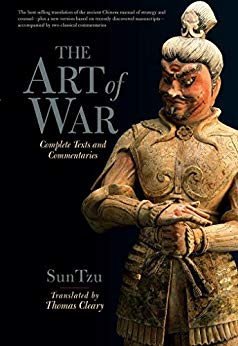

This article is an excerpt from the Shortform summary of "The Art of War" by Sun Tzu. Shortform has the world's best summaries of books you should be reading.
Like this article? Sign up for a free trial here .
In The Art of War, Sun Tzu says, “Strategy without tactic is the slowest route to victory.” What did Tzu mean by this? What is strategy without tactic?
We’ll cover what Tzu says is the slowest route to victory. Learn how the strategic use of resources and management of troops can win you the battle.
Strategic Use of Resources
Why is it that strategy without tactic is the slowest route to victory? You can have a good general strategy, but if it’s not reinforced by solid tactics, your plan will fail.
Part of a competent strategy is the intelligent use of resources, a tactic. Resources relate to everything needed for battle, including food, troops, money, and weapons.
Once you’ve assessed the five traits, amassing and training your fighting contingent is the next priority. You should only gather fighters when you deem the battle to be absolutely necessary and believe victory is the likely outcome. Amassing a force before you determine this exploits the motivation, energy, and good faith of the people. If you assemble forces too early, the public and troops will be weary when the need becomes a reality later.
Soldiers should be properly trained in combat tactics and shaped into a strong, loyal force through the use of rewards and punishments. Rewards and punishments should not be arbitrary. You should deliver both fairly across the ranks according to clear and legitimate boundaries. These types of rewards and punishments motivate people for success. Rewards and punishments handed out too readily or in a disparate manner will breed complacency and mistrust. Using such seemingly minor tactics is key to the successful operation of the plan. Strategy without tactic is the slowest route to victory.
Reduce the use of supplies. You should avoid lengthy battles, which deplete food, money, and energy. When traveling great distances for battle, feeding off the enemy’s abandoned stores ensures your stores are maintained. Only use weapons when all other strategies for victory have been exhausted.
Strategic Maneuvering of Troops
Momentum is the life force of any conflict. When momentum is on your side, you have the advantage. You can create this advantage by manipulating your enemy into action.
When the enemy is forced into action, they must adopt a certain formation. The formation of both your troops and the enemy’s speaks to the psychological conditions of each. Therefore, if the enemy takes a certain form, you can deduce their strengths and weaknesses, using the latter to create a strategy for attack. To avoid allowing the enemy to have this information about your forces, you should remain formless. Formlessness is a tactic: Strategy without tactic is the slowest route to victory.
Formlessness is a manifestation of defense. When victory is not certain, you should lay low, fortify your position, see to the health of your troops, and appear unorganized. If your troops are unseen, your strategy cannot be known. If your strategy and strength are unknown, the enemy may be lulled into a state of complacency or bravado, both of which lead to careless behaviors.
Wait for a vulnerability to appear in the enemy, then attack that weakness swiftly using orthodox and unorthodox offensive tactics. Orthodox tactics signify traditional formations and fighting techniques. These are standard modes of battle, such as structured face-to-face combat. Unorthodox tactics include combat techniques outside the typical forms, including sneak attacks, espionage, and deception. When used in harmony, both tactics can lead to advantages in battle, and we know that strategy without tactic is the slowest route to victory.
Finally, when you have the advantage, you are in a state of fullness. If you lose the advantage and are forced into offense, you are in a state of emptiness. If you are empty but your opponent is full, victory cannot be guaranteed. If victory cannot be guaranteed, you should adopt a defensive position. Fullness should only attack emptiness. If both sides are full, wait until a vulnerability opens up in your opponent, then attack.
Gaining Advantages
The lay of the land should be considered a branch of your strategy. There are several types of terrain, each encompassing advantages or disadvantages, depending on the nature of the geographical structure. For instance, easily passable terrain allows either side to move freely in and out, whereas unwelcoming terrain hinders the movement of either side, thereby presenting only disadvantages. On easily passable terrain, you want to gain position first and wait for the enemy, giving you the advantage of preparation. On unwelcoming terrain, no advantage is attainable, so you should avoid entering this terrain and be wary of opportunities for gain.
Likewise, there are several grounds on which a fighting force may traverse, and each involves a psychological consideration and suggested action. For instance, light ground describes the fringe of enemy territory, whereas heavy ground describes a position deeply entrenched in enemy territory. On light ground, retreat is easy and your troops are not fully immersed in the conflict. You should move through light ground quickly so as not to allow the troops’ motivation and mental commitment to wane. On heavy ground, retreat is more difficult. On this ground, your troops are resigned to the prospect of danger and will be more motivated to fight to the death. You should keep specific conditions and tactics in mind when developing a strategy: Strategy without tactic is the slowest route to victory.
Understanding the different types of terrain and grounds is as essential to determining victory as training and assessment of the five traits are.
Strategy Without Tactic Is the Slowest Route to Victory
The Goal Is to Win When It Is Easy
Strong leadership involves knowing when and how to mobilize during conflict. You must understand the constitution of your troops and officers and how to motivate them in varied circumstances. You must be cunning and intelligent in planning your strategy, but you must also be adaptable and capable of allowing the actions of the opponent to guide your decisions. The principles laid out in The Art of War will give you the wisdom and strategies you need to become this type of leader and learn how to seek victory when it can be attained swiftly and easily. If you can be disciplined enough to only enter into battle when victory is assured, you can manage any conflict in your life.
———End of Preview———

Like what you just read? Read the rest of the world's best summary of "The Art of War" at Shortform . Learn the book's critical concepts in 20 minutes or less .
Here's what you'll find in our full The Art of War summary :
- How to mislead your enemies to win the war
- Classic examples from Chinese history to illustrate Sun Tzu's strategies
- How to use spies to gather information and defeat your opponents






